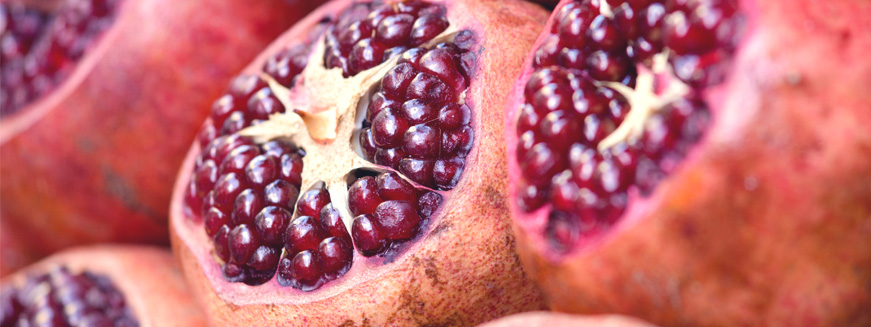The Fresh Blog
Lifestyle, Health, Nutrition & Inspiration from Luvo
Know Your Food: Pomegranates 101
Many of the most wonderful foods in this world require the most work to enjoy their deliciousness. Take pomegranates for example. People are always excited to share the secrets of how they magically extract the seeds from inside this pithy fruit without making a huge mess or sacrificing any of them to the kitchen floor gods.
There was a time when I didn’t think pomegranates were worth all of this effort. That was before I knew that they were a key ingredient in one of my most prized childhood treats: The Shirley Temple. A sweetened syrup made from pomegranate juice, also known as grenadine, gave my Shirley Temple a ruby red color at the bottom which I swirled around until the drink became a pretty coral pink. Little did I know that I would remain fascinated by such potions well into my adulthood.
Global Pomegranate Love
Native to Iran and northeast Turkey and cultivated around the world, pomegranates are something of a hot food commodity right now in North America, with many people reaching for bright red bottles of juice on shelves across the continent. While their popularity seems to be somewhat of a new development here, pomegranates and their juice have been a staple in many cuisines around the world for quite some time, including Persian and Indian. The ancient city of Grenada in Spain was also named after them.
Pomegranate Nutrition
Pomegranates are a good source of dietary fiber (when the seeds are eaten), which supports healthy digestion and weight management, and antioxidant vitamin C, which is beneficial for strengthening immunity. Studies have indicated that their unique and powerful antioxidant content may help reduce the risk of several cancers and cardiovascular conditions.
The Secret to Removing Pomegranate Seeds
I’ve tried several ways to remove pomegranate seeds from their pithy shells, from freestyling it to submerging the cut fruit in water and picking out the seeds by hand. In the water method, the seeds sink to the bottom for easy separation from the inedible core. The best method I’ve come across, however, is to cut the fruit in half, then hold it seed-side down over a bowl while beating the sides of the fruit with a wooden spoon. The seeds magically pop out of the shell and into the bowl with very little effort. You might need to scoop a few deeply embedded seeds but this way is by far the easiest I’ve discovered. It also keeps the red juice mess to a minimum.
Culinary Uses
Beyond their juice, which can be enjoyed on its own or added to your smoothies, pomegranates are used to make soups, salads, glazes, relishes, dips and even spices. The seeds can be sprinkled on or cooked in a variety of dishes, ranging from sweet to savory.
- Their unique tanginess and texture adds an interesting dimension to grain-based salads.
- Jamie Oliver may be onto something with his Coconut Pancakes with Pomegranate Jewels.
- The bright red seeds create festive colors in this recipe for Holiday Guacamole.
- This recipe for Persian Lamb uses pomegranate molasses in the roasting pan and pomegranate seeds in the side salad.
- Try cooking with dried pomegranate seeds (also known as anardana) in this Dry Pomegranate Chutney recipe, perfect for dipping your samosas or pakoras.
Do you have a favorite pomegranate recipe? Share it with us in the comments, on our Facebook page, or on Twitter at @luvoinc.


